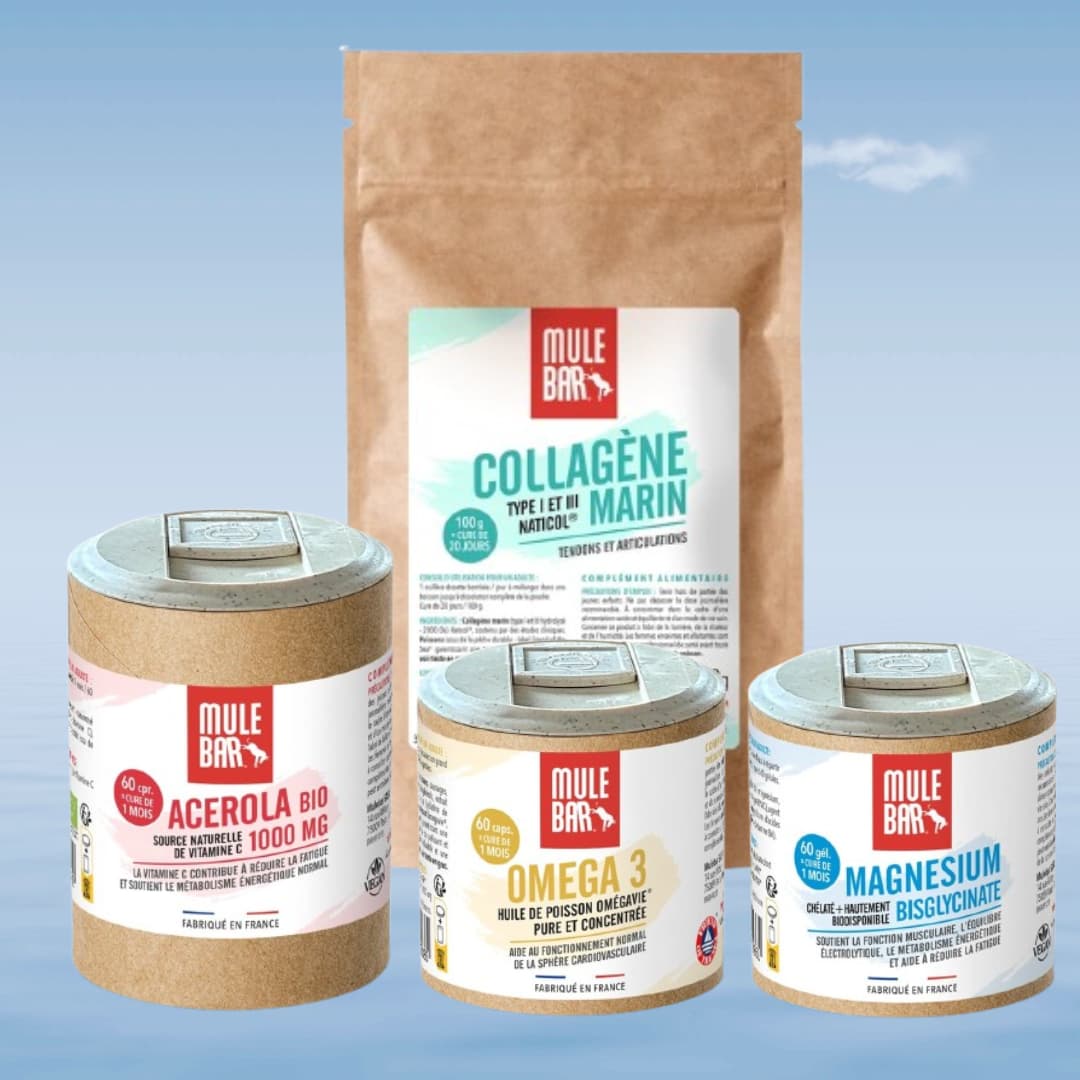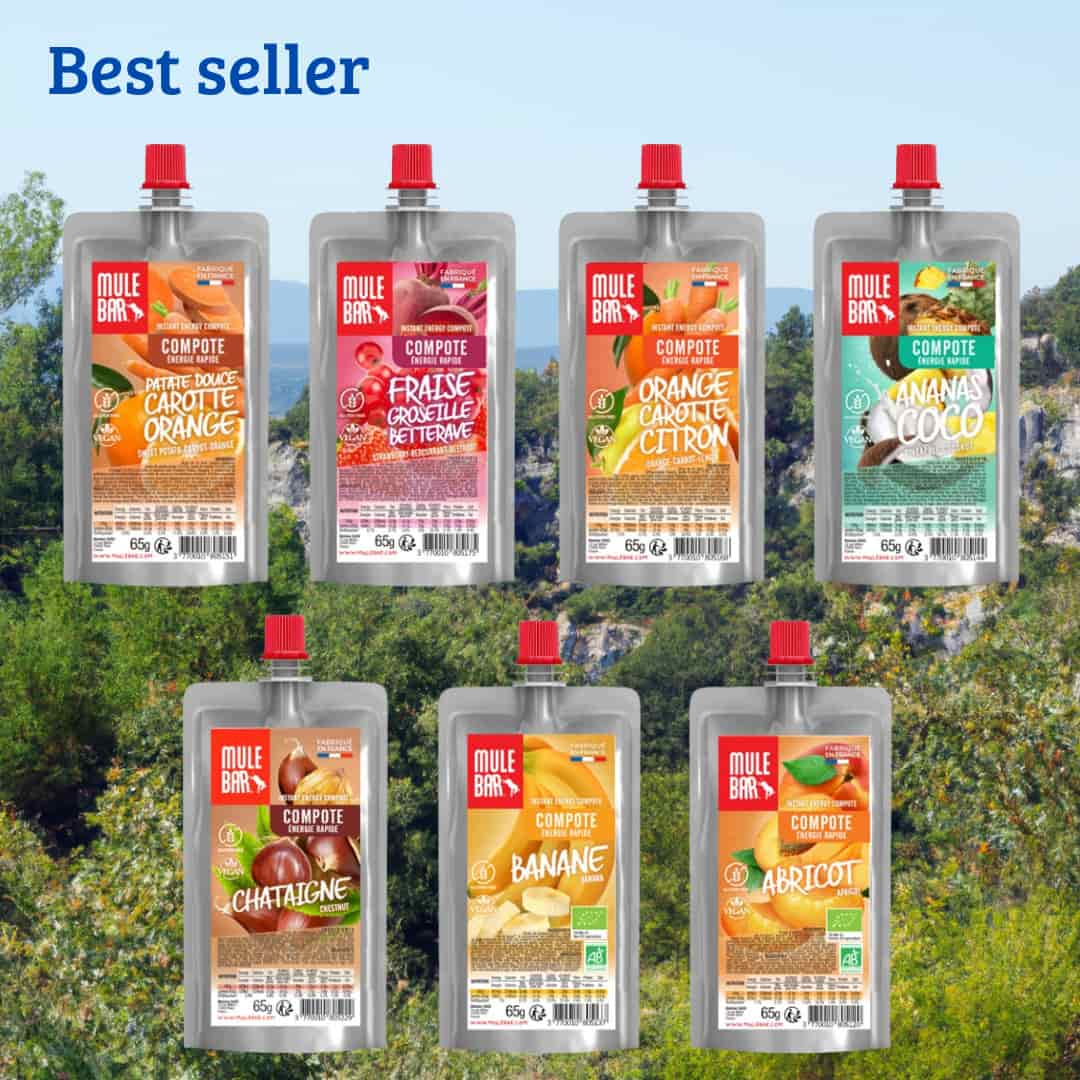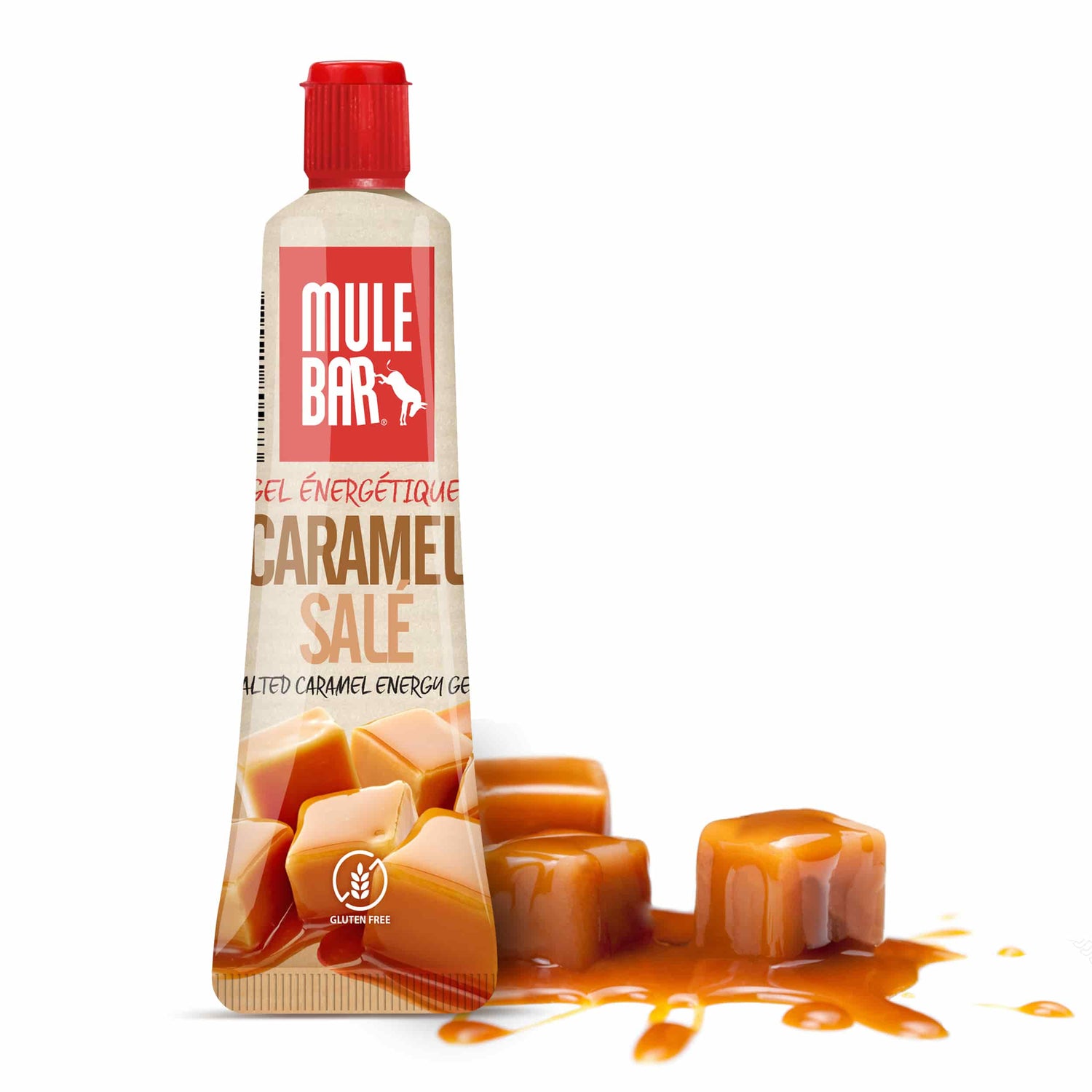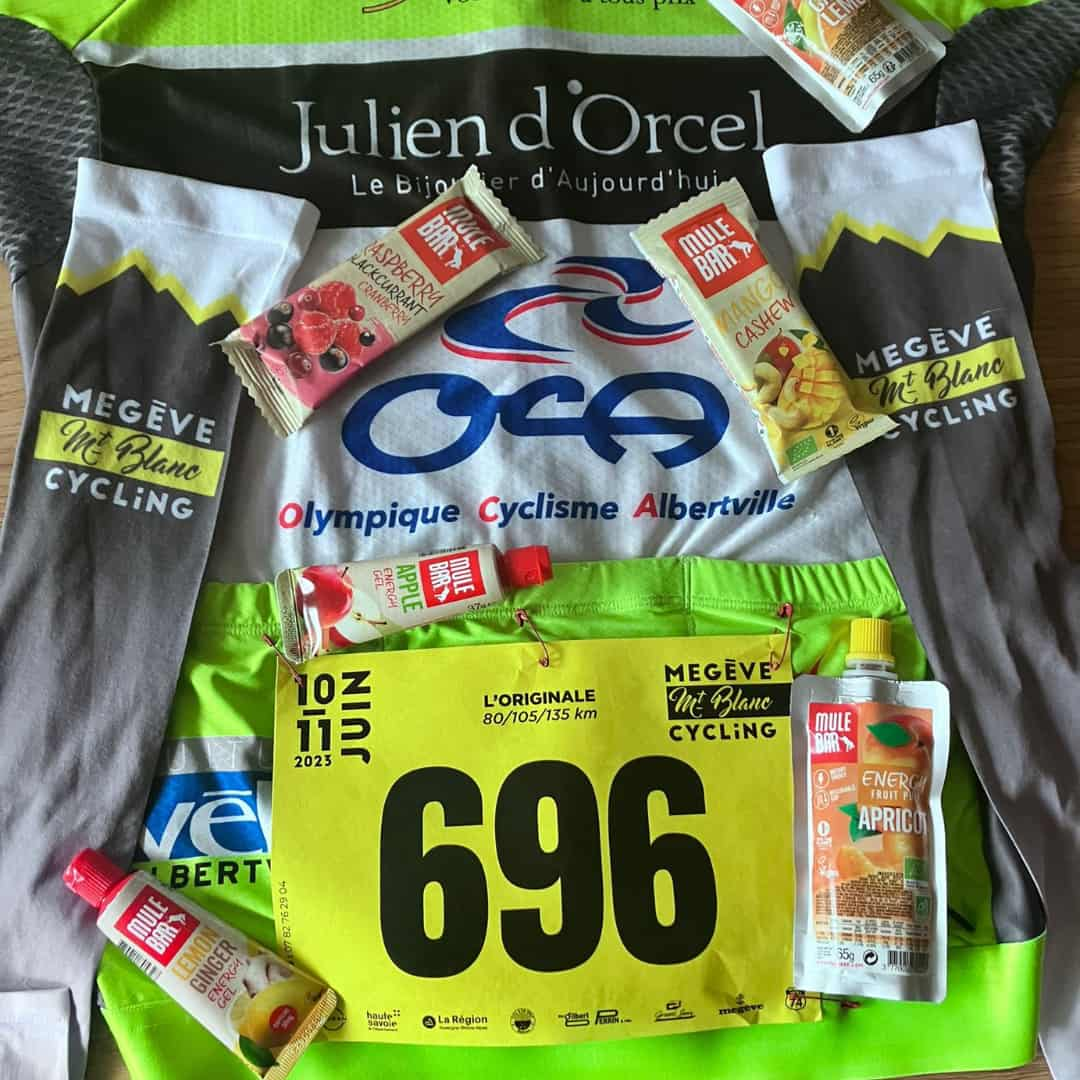Making your own energy gels is cheaper than buying commercial gels for those who have the time to "cook" them. By understanding the role of each ingredient, you can customize the texture, taste, and energy content to your needs. With 17 years of experience in sports nutrition, Mulebar gives you all the tips and tricks to ensure your preparation is a success. Our homemade energy gel recipes will allow you to create a natural preparation with the right balance of carbohydrates and electrolytes, based on our Mulebar gel recipes. Below, we also show you how to use our reusable silicone flasks to package your mixtures in a practical and eco-friendly way.
Why are carbohydrates important during exercise?
Glucose is the primary fuel for muscles and the brain during physical exercise. The body stores approximately 400–500g of glycogen in the muscles and liver. These reserves are sufficient for 1.5 to 2 hours of intense effort, but no more. After that, without external replenishment, performance drops. In running, this is known as hitting the "marathon wall," while in cycling, it's called hitting the wall. Hence the importance of external glucose intake through gels, drinks, or energy bars.
| Type of effort | Duration | Objective | Recommended carbohydrate intake |
|---|---|---|---|
| Short effort | < 45 min | No need | No external input needed |
| Medium effort | 45–75 min | Maintain blood sugar | Rinsing in the mouth is possible (10–20 g/h) |
| Average endurance | 1–2h | Avoid energy depletion | 30–60 g of carbohydrates per hour |
| Long endurance | 2–3h | Avoid glycogen depletion | 60–90 g/h (with 2:1 glucose/fructose ratio) |
| Ultra-endurance | > 3h | Maintain energy + digestive comfort | Up to 90–120g/h (if digestive tolerance is maintained) |
Energy gels and essential ingredients
What is an energy gel?
An energy gel is a concentrated source of carbohydrates that provides quick and sustained energy during exercise. Our recipes combine different sugars: agave syrup (fructose) and rice syrup (glucose) for an effective energy boost, without the additives or preservatives found in industrial products, thus eliminating the risk of stomach upset. You can adjust the consistency by adding a little water to make a thinner gel or even a hydrogel.
Thanks to its fluid consistency, this gel is easy to swallow, even with a dry mouth, which is very common during exercise, and its effect will be felt within 5 to 10 minutes. Ideal before key moments in a race. A 37g serving provides approximately 25-30g of carbohydrates (100-120 kcal), with a pinch of salt (50-150mg of sodium) to replenish minerals lost through perspiration without overloading the stomach.
How does this translate into practice?
-
1 energy gel (≈ 25g of carbohydrates) every 20–30 min depending on intensity.
-
2 gels / hour or 1 gel + energy drink, i.e. approximately 60g/h.
-
For efforts lasting >2 hours, aim for up to 90g/h by combining two types of sugars, glucose/fructose (2:1 ratio), to maximize intestinal absorption.
Key ingredients and proportions
The ideal base consists of 60% brown rice syrup (fast-acting energy, high glycemic index of 90), 30% agave syrup (sustained energy, low glycemic index of 15), 10% fruit concentrate, a pinch of pink salt rich in trace elements, and water. This mixture stabilizes blood sugar levels and replenishes minerals lost through perspiration.
Fruit concentrate provides antioxidants and flavor. If the mixture is too thick, add a little water. Opt for fruits like cherries or apples for their antioxidant benefits, and avoid fiber and fats, which slow down absorption.
For nighttime efforts or difficult finishes, you can add 50 to 100mg of natural caffeine (via guarana or coffee, for example), the equivalent of one or two strong espressos. Caffeine combats fatigue and improves concentration if it is well tolerated by your body.
Energy gels: easy recipes using natural ingredients
Discover below our recipes for ultra-easy homemade energy gels, perfect for your cycling, trail runs, or marathons. Each version uses basic ingredients for a smooth texture and a balanced carbohydrate intake, ideally suited to physical exertion. You'll get gels with the perfect consistency, easy to absorb, and delicious.
Recipes for homemade Mulebar energy gels
Our energy base for homemade gel is prepared with 20g of rice syrup, 10g of agave syrup, and 0.2g of Himalayan pink salt. The perfect texture is achieved by gently heating the syrups in a double boiler. Mix well until you obtain a smooth consistency.
- Brown rice syrup : provides rapidly absorbed glucose for an immediate energy boost. At Mulebar, we call it a kick !
- Agave syrup : Fructose with sustained energy release over 30 to 45 minutes
- Pink salt : compensates for sodium and mineral losses due to perspiration
For flavor, add 3g of fruit concentrate of your choice, coffee or salted caramel and hot water to adjust the consistency to your taste.
A gel does not need vitamins, BCAAs or other additives because you will find them in greater quantities in your sports or hydration drink.
Variations with honey or maple syrup
For 8 servings of 25g each, mix 60g of liquid honey, 60g of agave syrup, 70ml of fruit juice, and half a teaspoon of salt. This simple recipe can be enhanced with 5g of spirulina and a pinch of ginger or turmeric.
Honey provides essential enzymes and minerals, while maple syrup supplies manganese and zinc for sustained energy. These combinations are ideal for triathlons, cycling events, marathons, and ultra-trails because they intelligently balance carbohydrates and electrolytes without causing digestive discomfort.
What should you use to package your homemade energy gels?
Our Mulebar soft food-grade silicone flasks (BPA-free) are available in two sizes: 60ml (equivalent to 2 gel tubes) and 150ml (approximately 7 tubes). Their wide opening makes filling easy, their resealable, leak-proof cap prevents spills, and their translucent walls allow for precise dispensing.
We invented these containers in 2012 to prevent the waste of single-use plastic tubes that are still too often found on the side of roads and paths. Since all gels on the market are packaged in non-resealable containers, some very sticky product always remains inside, which is why some people prefer to throw them away rather than put them back in their pocket.
Their ergonomic design and soft silicone protect your technical clothing from snags. They are easy to clean and allow for gradual consumption (1/4 of a 60ml flask every 10-15 minutes) for consistent energy.
Because our Mulebar gel tubes are resealable with a proper cap, just like a toothpaste tube, you can rinse them with hot water and reuse them dozens of times. The best way to refill them is with a syringe.
Once filled, store the flasks or tubes in the refrigerator. They will keep for weeks, like honey or jam, because sugar is an excellent preservative. After use, a rinse with hot water is sufficient. Let them air dry and store in an airtight container.
Turn your homemade gel into a drink
Dilute a portion of your preparation in 500ml of water to create a sports drink. This allows you to alternate between concentrated gel and a lighter drink, thus optimizing hydration and digestibility during exercise.
In warm weather, this liquid version promotes better hydration. In cold conditions, homemade energy gel remains practical because it doesn't freeze. Prepare your bottles in advance to easily control your intake during the race.
Eat smaller portions and hydrate wisely
Instead of taking all your gel at once, divide it into three small sips spaced 10 to 15 minutes apart. This method stabilizes your blood sugar levels and minimizes digestive problems or blood sugar spikes.
Cyclists and triathletes generally tolerate gels better thanks to a position that puts less pressure on the stomach. In trail running or road running, the repeated impact disrupts digestion more. In these cases, opt for a more fluid texture and consume gels in smaller, more frequent portions.
Remember to drink 50 to 100 ml of water after each dose of gel. Water aids intestinal absorption, cleanses your palate, and prevents that unpleasant pasty mouth sensation. Proper hydration also speeds up the transport of carbohydrates to your muscles and reduces the risk of nausea.
Test your energy gels during training
Always test your homemade energy gel recipe during training before a competition. Tolerance varies depending on the carbohydrate source: honey, syrup, or agave syrup react differently in different people. These tests will help you adjust the proportions for race day.
More environmentally friendly, more practical, more economical
Our 444g eco-refills are equivalent to twelve 37g Mulebar gel tubes but cost only the price of 7.6 gels sold at retail. This reduces both your expenses (33% discount) and your environmental impact. Good for the planet, good for your wallet !

What are the alternatives to energy gels?
For those who find gels too sweet, the ideal alternative is energy fruit compotes, which are just as convenient but slightly thicker and fruitier. You can consult the complete guide to the different energy fruit compotes on the market.
Frequently Asked Questions
What is the ideal composition of a homemade energy gel?
To create an effective homemade energy gel, use approximately 60% high-glycemic index syrup (such as brown rice syrup) combined with 25% slow-release syrup (agave or maple). Add 10-15% fruit concentrate, along with a pinch of salt for electrolytes. This mixture provides 25-30g of carbohydrates, or 100-120 kcal, which are quickly absorbed in less than 10 minutes.
How to make homemade gel without it being too thick?
The perfect texture is achieved by gently heating the syrups in a double boiler before adding the other ingredients. If the consistency is still too thick, thin it with a little hot water, concentrated orange juice, or liquid purée. Check that the mixture flows easily from a spoon without forming lumps.
How long can you store homemade energy gel?
Since sugar is an excellent preservative, your homemade energy gel will keep for weeks in the refrigerator in silicone flask-type containers.






Leave a comment
This site is protected by hCaptcha and the hCaptcha Privacy Policy and Terms of Service apply.